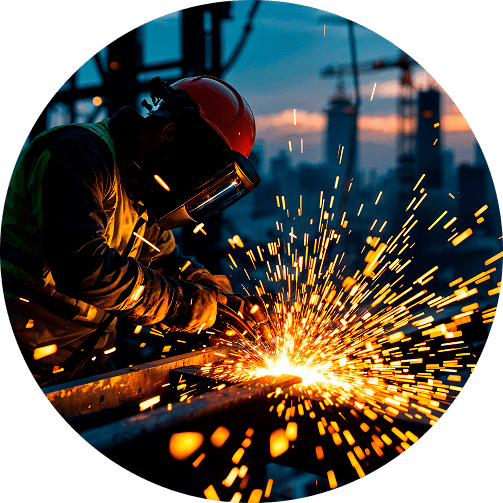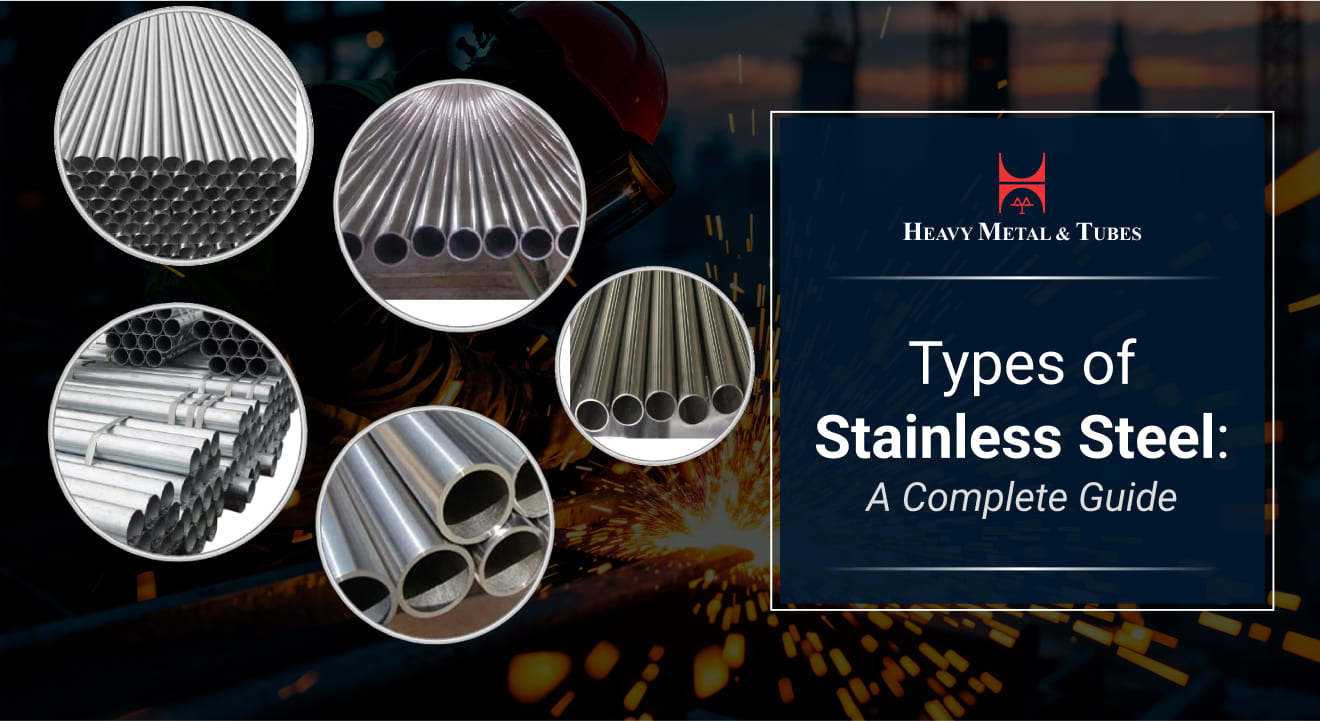Types of Stainless Steel: A Complete Guide
When we think of stainless steel what usually comes to mind is that of a shiny kitchen sink or appliance. But stainless steel is more than one type of material – it is a group of iron based alloys which are developed to resist corrosion and to do well in rough environments. Each stainless steel product is put out with certain elements and performance features that range from heavy duty industrial to sanitary grade.


As you look into stainless steel products such as pipe, cold drawn bar, or high strength U tubes, which grade you choose can make large scale changes in how durable it is, what it will do, and the cost. This blog will go in to the various types of stainless steel, what their main properties are, what they are used for, and tips on what to look for when you want to choose the best one for your needs.
What Makes Steel “Stainless”?
Steel is made “stainless” when it has at least 10.5% chromium. This chromium reacts with oxygen in the air to produce a thin stable oxide layer which forms on the steel’s surface. That’s the element which gives it the rust and corrosion resistant quality even in the presence of moisture, chemicals, or acid.
Also included in the mix are elements like nickel, molybdenum, nitrogen, and manganese which we put in to improve certain properties – from increase in strength to better performance in extreme heat or salt. It is these variations which create the many types of stainless steels.
Also See: Seamless Steel Pipes for Every Industry Need
Main Categories of Stainless Steel
1. Austenitic Stainless Steel
It is widely used. They are non-magnetic, very corrosion resistant and easy to work with. Due to high levels of nickel and chromium they perform well in almost all environments, from food processing units to industrial tanks.
- Common Grades: 304, 316, 321
- Features: Non magnetic, large scale corrosion resistance
- Applications: Food industry for piping, medical instrumentation, architecture, marine
2. Ferritic Stainless Steel
Ferritic stainless steels are more economical and low in nickel. They are magnetic but still have good protective qualities. May not be as ductile as the austenitic types but work great in simple design elements.
- Typical Grades:430, 409
- Features: Magnetic, also has issues with oxidation
- Usages: Automotive accessories, washing machines, kitchen exhaust venting
3. Martensitic Stainless Steel
Martensitic types are strong, hard, and capable of being heat-treated. These are magnetic and usually used where wear resistance is more important than corrosion resistance.
- Common Grades:410, 420
- Features: Heat treatable, magnetic
- Applications: Surgical tools, pump axles, knives, fasteners
4. Duplex Stainless Steel
This type combines the features of ferritic and austenitic groups. In a dual phase structure, it provides great strength as well as high corrosion resistance against chloride stress.
- Common Grades:2205, 2507
- Description: Very strong and corrodion resistant
- Uses: Offshore oil platforms, chemical storage tanks, construction
5. Precipitation Hardening Stainless Steel (PH)
PH steel is made for ultimate strength through heat treatment. Also has very good corrosion resistance, does very well in aerospace and defense.
- Common Grades:17-4 PH
- Features: Extreme strength, can be heat treated
- Applications: Airplane parts, turbines, nuclear systems
Read More: Boiler and Heat Exchanger Tubes: Definition, Applications & Industry Benefits
Common Grades of Stainless Steel and Their Properties
304 Stainless Steel: We see 304 which is the most common type of stainless steel that does very well against corrosion, is easy to work with, and does great in many different environments. It has 18% chromium and 8% nickel.
Used in: Food processing equipment, kitchen sinks, stainless steel pipes, utensils, tanks
316 Stainless Steel: This is similar to 304 but also has molybdenum which improves its performance in chlorides and salt water. It does best in very tough environments.
Used in: Marine applications, pharmaceutical plants, chemical containers, seamless stainless steel pipe suppliers
430 Stainless Steel: A ferritic and magnetic grade which does a good job at corrosion and oxidation resistance at moderate levels. Also it is lower in cost which makes it a good choice for decorative and indoor use.
410 Stainless Steel: A martensitic stainless steel known for its strength and hard wear resistance. While not as good at corrosion as the austenitic types it does great in environments which care more about durability.
Used in: Cutlery, surgical instruments, valves, and mechanical parts
17-4 PH Stainless Steel: This is a precipitation hardening steel which has a balance of high strength and good corrosion resistance. Also, it may be heat treated to different levels of strength.
Used in: Aerospace components, petrochemical equipment, heavy duty shafts
Applications by Stainless Steel Type
- Austenitic: Common in stainless steel pipe, food-grade tanks, sanitary fittings, and cold-drawn stainless steel bar production
- Ferritic: Used in kitchen appliances, heat exchangers, cold-drawn stainless steel flat bar, and decorative trims
- Martensitic: Ideal for pumps, scissors, blades, and tools that require strength over corrosion resistance
- Duplex: Strong and corrosion-proof — perfect for marine structures, chemical storage, and heavy-duty pipework
- Precipitation-Hardening: Used in aerospace hardware, turbine blades, nuclear waste containers, and robotics
Factors to Consider When Choosing Stainless Steel
When selecting stainless steel, here are the top factors to weigh:
- Corrosion Resistance: Is the environment corrosive (e.g., salty air, chemicals)? If so, 316 or duplex might be best.
- Strength Requirements: Will the material need to hold heavy loads or pressure? Choose duplex or 17-4 PH.
- Formability: Need to bend or weld the steel? Austenitic grades like 304 and 316 are easiest to work with.
- Magnetism: If magnetism matters for your application, go with ferritic or martensitic types.
- Cost: For budget-sensitive projects, ferritic grades like 430 offer decent performance at a lower cost.
- Temperature Resistance: In high-heat areas, special grades like 310 or 446 work better.
Stainless Steel Finishes and Why They Matter
Stainless steel isn’t just about composition — its surface finish affects how it performs and looks.
- 2B Finish: Smooth, matte finish used for general industry or internal parts
- No. 4 Finish: Brushed finish — great for kitchens, elevators, and visible surfaces
- Mirror Finish: Highly reflective and polished; perfect for décor, signage, and design applications
Each finish affects cleanliness, corrosion resistance, and aesthetics — so pick one that matches your use case.
Choosing the Right Stainless Steel Partner: Heavy Metal
The quality of your stainless steel supplier is a factor in how well your products perform, how long they will last, and also in terms of compliance. At Heavy Metal we do more than just sell stainless steel – we work with you to find out what material you truly need for that job.
We supply from a large variety of grades and sizes of cold drawn stainless steel bars, seamless stainless steel pipe, stainless steel “U” tubes, and high precision flat bars. We partner with oil & gas, food processing, pharma, and construction industries which we know inside out and which we help balance out in terms of cost, availability and performance. We are not just suppliers -- we are your long term partners.

Conclusion
Stainless steel does not fit all applications. We have many types including 304, 316, 410, or 17-4 PH each with their own benefits and best use. In choosing which grade to use, think of where and how the material will be used, what environment it will be in, and what performance you want over time
From cold drawn stainless steel bars to seamless stainless steel pipes we have a large range and the right choice comes from knowledge. At Heavy Metal we are here to help you make that out with confidence.